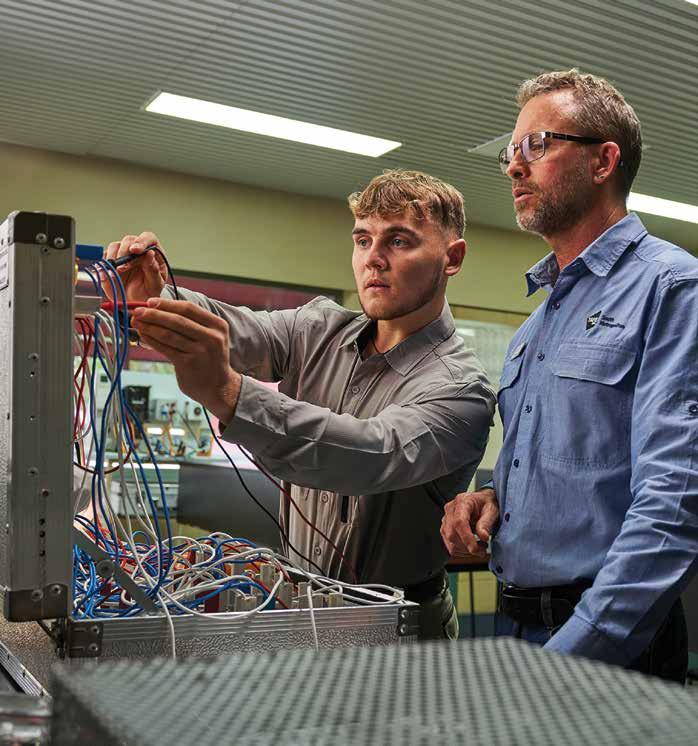
4 minute read
GROWING A SMART AND TECHNOLOGICALLY SAVVY DEFENCE INDUSTRY WORKFORCE
By Hon Sue Ellery BA MLC,
Minister for Education and Training, Government of Western Australia
The impact of COVID-19, record low unemployment and a strong economy have seen demand for skilled workers hit an all-time high. The McGowan government remains committed to growing Western Australia’s defence industry workforce, recognising its vital importance for economic diversification and job creation. Key to this is our work with the defence industry and tertiary education providers to create a pipeline of skilled workers for the sector.
Successful local WA companies like R. Moore & Sons are set to benefit from training and skilling programs that will attract the workers the defence industry needs. © WA DEFENCE REVIEW.
INCENTIVISING GROWTH
As part of our commitment we invested $18.34m to continue building WA’s defence ‘blue collar’ manufacturing workforce and launched a campaign to attract workers to careers in WA’s defence industry. The state is also positioning itself to grow its professional and technical workforce and develop its capability and STEM skills to address the high-tech requirements of the industry.
The package will enhance WA’s capacity to secure future Defence work and includes $8.5m towards $20,000 incentives for defence manufacturing industry employers to train apprentices in key trades, $2.85m to create an additional 335 apprenticeships in nominated trades, and scholarships for women and Defence veterans.
The sophistication of our nation’s Defence assets and systems means that the defence industry workforce which builds and sustains them must have the technological skills and innovative approaches to keep Australia’s Defence capabilities at the leading edge - particularly in a global environment that is uncertain, complex and competitive. SMART WORKFORCE HUB
The rapid push to remote, automated and digital solutions during the pandemic has also highlighted an opportunity for all

SM TAFE offers tailored training programs to meet defence industry skilling and training requirements. © SM TAFE.
industries, including the defence industry, to streamline operations and build future capability.
To this end, the WA government is seizing the opportunity to position WA as a ‘smart’ defence workforce hub, leveraging the high-tech strengths of the WA labour market and linking world class capabilities across a range of industry areas. This focus on building a high-tech future workforce is supported by WA’s world-class universities and training institutions, which have demonstrated in the past that they can meet the surges in workforce demand when needed.
For example, South Metropolitan TAFE has been working with Defence to develop a bespoke training program to attract and support new entrants to

…the WA government is seizing the opportunity to position WA as a ‘smart’ defence workforce hub, leveraging the high-tech strengths of the WA labour the industry. The Defence market and linking world class Industry Pathways Program (DIPP) offers capabilities across a range of industry areas. participants a taste of the defence industry to help them decide on a career pathway. Developing and futureproofing our workforce is high on the agenda. It is why four of WA’s universities (Curtin, Edith Cowan, Murdoch and the University of WA) are collaborating on defence-related research and education as ‘Team WA’, a concept unique to our state. And it is why the McGowan government is investing heavily in TAFE and our schools to build the pipeline of technologically skilled workers to meet the defence industry’s future needs.
Credit: Envato Elements.
DEEPER COOPERATION
Through the Western Australian Defence and Defence Industries Strategic Plan, we have set our objectives to align with the future of Defence. Growth in Australia’s defence manufacturing capabilities will have benefits for the broader economy and will lead to increased capability for other national manufacturing priorities, and vice versa. This is particularly the case as Defence capability and broader technology evolves and adopts Industry 4.0 technologies, which could deliver significant benefits in terms of building agility and tailored customer-centric products.
This emphasis is being supported by the work of the Department of Training and Workforce Development, Western Australian Defence Industry Workforce Office and the Department of Jobs, Tourism, Science and Innovation in their facilitation, policy and planning roles. This demonstrates the deep collaborative approach being taken here in WA between industry, education and training, and the government. This is absolutely vital, supporting local businesses to grow, and win more defence contracts over time.
Work is also underway to develop workforce plans for the other four Defence capability domains of air, land, space, cyber and information, with an industry survey being recently deployed in collaboration with Defence West, 4th Harmonic and Industry Capability Network WA. Again, the high-tech nature of workforce needs in these areas is expected to be prominent.
It is vitally important that WA continues to build on its collaborative approach, focusing on growing a smart and technologically savvy defence industry workforce.










